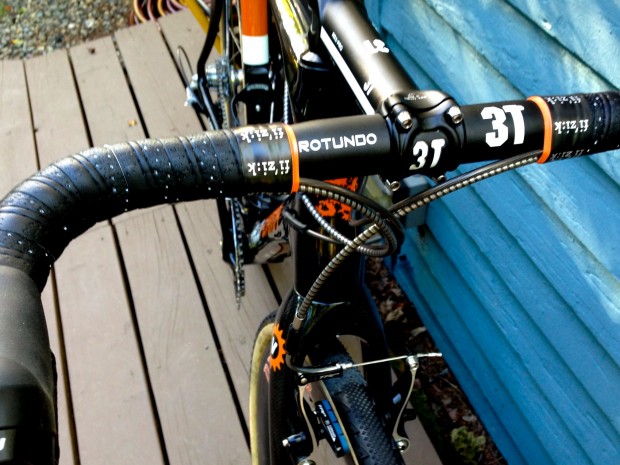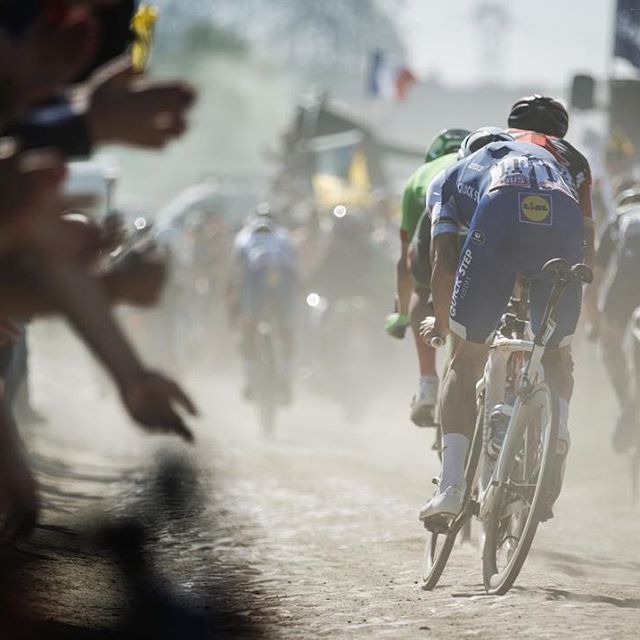La Vie Velominatus: Cable Obsession

I’m fluent in three languages: Dutch, English, and Hyperbole. The third is an acquired talent developed by creative and narcissistic tendencies; the narcissism feeds a belief that normal words can’t properly describe the magnitude of my experiences, and the creativity struggles to cope with restrictive paradigms like “facts” and “reality”. I have also been diagnosed with obsessive-compulsive disorder which, when taken with everything else, suggests that my darling partner exhibits some questionable judgement.
I have a visceral response to clutter; when I see things out of order, my insides turn about themselves and cause me physical discomfort. If the clutter escalates to becoming a “mess”, my mood changes and I become irritable. This applies to everything from our house, my workshop, my office, desk space, my computer desktop, my briefcase, and my bicycles’ cable organization. I don’t have to tell you that the last one is the only one that really matters.
The tidiness of the cables on a bicycle are one of several key factors that elevate the Velominatus above the Common Cyclist. The old style of STI shifters and their protruding cables were barbaric; they represented a principle reason for my dislike of Shimano’s system. Campagnolo took a few extra years to produce the Ergo shifters, and I am quite convinced they spent that extra time sorting out how to internally route the cables.
The organization of a rider’s cables and the length to which they are trimmed is a critical detail to which we must all pay close attention. No matter how beautiful the bike, disheveled cables will always bring it down. I hereby give you the V Principles of Cable Routing:
- It is of paramount importance that the housing exit the bar tape at precisely opposite points on the bars. This extends beyond the cables taken in aggregate, and applies to both the brake and shift housing meaning that if they are routed together, the brake cable must always be below the shift cable, and if they are route front/back on the bars, they must both be routed in the same fashion.
- The housing must be organized such that they mimic and mirror each other’s curves to the maximum capability of the frame and application. This is to say that housing intersections and contact points must be minimized and under no circumstances may a shift-brake cable pair be split by another cable running from its mirrored set.
- Cable housing must be cut to the shortest length possible while still allowing full movement of the handlebars. It must, however, be cut long enough to allow that the cables run in a smooth curve at all points, minimizing friction. The shift cables should be cut such that they overlap only slightly; the ideal is that they just kiss each other at the apex of their arch to the frame.
- Inner cables must be cut to a length not exceeding 2cm. The ideal length is 1.5 times the length of the cable end.
- Cable ends will always be crimped using a crimping tool. Extra points awarded for a diagonal double-crimp. Under no circumstances are frayed cables to be tolerated.
Go with Merckx, and do not violate these principles. Vive la Vie Velominatus.
[dmalbum path=”/velominati.com/content/Photo Galleries/frank@velominati.com/Cables/”/]


The orphaned cantilever support makes me sad.
Do you worry about cable rub on the Veloforma head tube?
I ditch the cable ends and instead superglue the cut tips of the cables.
Hmmm. I’ve just re-cabled and tape my bike and having seen the photos above maybe I should consider doing it again. I’m pleased with the tape job although the finishing tape could be better. The cables on the other hand could definitely be better.
In my defence, though, I suspect it’s probably easier to get a neater cable set up if you happen to need a 12 foot Dutch Monkey stem. Using a (considerably) shorter stem seems to push the cables forwards which doesn’t work so well. That said there is room for improvement and I’ll also start saving for a bike that is much to small for me so I can go for a frankenstem.
@Chris
Clever
I’ve been wondering if there was a Rule on inner cable length of cut.
What was I thinking waaaay back then?! Actually I wasn’t, therefore the tow rope hanging from my front caliper.
I use to use a soldering iron with solder to neaten the cable end, then cut off the fray if any.
Ferrules are much nicer and with so many colours to choose from.
I just realized my rear brake cable runs between the other 2.
ugh.
the fizik finish tape looks better legible from the front, not while mounted. you seem to be of both camps, frank.
bullet point 1 is a pet peeve of mine. how some guys can have cables taped up forward of the bar, and the other side taped at the bottom position or rear, near palm, baffles me. no visual symmetry makes not a happy roger
@offroaded
If by that you mean that choosing brakes with stopping power is a violation of Rule #5, then I suppose you have a point.
This applies to everything from our house, my workshop, my office, desk space, my computer desktop, my briefcase, Gianni’s wallet and my bicycles’ cable organization.
The ideal length is 1.5 times the length of the cable end… What does that mean? 1.5 times the housing diameter? Gianni confused.
We used to solder the cable end too but stainless cable is wicked hard to solder or we lost out touch. It did look very tidy though.
@roger
He is covering his OCD bets. Very observant Wodger.
Lest those forget an emphasis on color choices.
Detailing to match the Columbus MXL decal.
@Marcus
You’ll have to be much more specific – which Veloforma? I’ve never worried about cable rub ever. That said, I have some little pads on the Strada iR that will keep it from happening and I’m using Jagwire’s rubber pads on the CCX.
I ultimately think cable rub is nothing to worry about and these are the first two bikes I’ve taken any precaution for – mostly just to do it and see if it helps.
And to bring the conversation to your level, cable rub can be fantastic.
@SloKenny
That’s a good approach. I was going to mention that soldering the ends is the most badass way to go, which is what my first Sensei did. He had spent years as the head mechanic for Helvetia La Suisse. He would also cut the cables basically to the bolt after soldering them. Class act, that one.
@Chris
That is some class rationalization. You must suffer from the same creative bent I do where reality has nothing to do with the theories you spin.
And then you redeem yourself. Frankenstem into the Lexi, then.
@Weldertron
Look like some jackhole even created special anchors to enable this horrible contravention. Remedy immediately. Luckily, you should be able to do what I did when I made this same mistake and just pull out the front brake cable and sort the mess out.
@sthilzy
Love that shot! Your front brake is like the strings on guitars from some of those guys who love leaving the ends long. (And yes, you can bet your life that my guitar strings are all neatly clipped.)
The soldering, as I just mentioned, is a classy way to go, if a bit unnecessary and labor-intensive. And I agree the color options may be fun. Something to explore. Orange, anyone?
@roger
I’m a bit of a switch hitter on this; I’ve always done it to be legible from the front, but then decided I wanted to try it the other way. Which meant I retaped all my bikes. Its pleasant from the rider’s position, but ultimately I think I do prefer it legible from the front.
@Gianni
Ah, yes. I forgot the wallet issue. All bills have to face the same direction, and all ordered from highest to lowest. The credit cards all go in opposite of the previous in order to increase the slimness of the package.
I will not leave the register before all this is sorted out correctly.
I mean that the distance from the bolt holding the cable to the beginning of the cable end should be .5 as long as the cable end. This is the perfect aesthetic balance and keeps things tidy by including the Proportion of V.
This was, apparently, much more prevalent than I thought. Top marks all around. We really are the Velominati. It was written long ago.
I think we should add that the correct brake lever should go to the correct caliper
and I will probably be whipped for this but I am not a huge fan of the v cogs on the handle bars.
@RedRanger
Me neither, they are gone already, to be replaced with matte black ones. Its just the only photo I had on hand with the correct routing.
@frank glad im not on the shit list then
@RedRanger Correct brake to correct caliper? I’ve broken my left wrist twice and it ain’t what it used to be, therefore my RH lever is the front brake cailper.
You’re right on the last comment. That’d be a chain whipping coming at ya!!
“Right shifter cable should go to the left cable stop and vice versa.”
Not sure I’m seeing a shit ton of this in any of these pics, but I ‘am’ visually impaired, not to mention ESBually and Chocolate Pumpkin Porterly impaired to boot.
@RedRanger
Kinda funny story: For the most part, we all have “right rear, left front” routing for brakes. My buddy left his bike out in his yard while he was cleaning his shop/ garage, and came out to find his sexy new GT had gone missing. While he was upset, and I was bummed about the theft for him, we did laugh that during the thieves getaway, he must have ended up on his face at the first stop, since his bike was cabled “motorcycle style”. Right lever= front brake.
@frank
Mmmm hmmm. While I know for a FACT, we discussed this not too long ago, I’m glad you’ve seen the light.
In fact, strict adherence to that rule, possibly the only one that’s had the slightest impact on my aesthetic sensibilities, led me to this arrangement:
Some Rule V riding yesterday in the gale force winds that prevailed have left the ‘Bolt a bit bespeckled, and the uncasual readers here will likely vilify the bar tape, but damn, that cable arrangement is not hard to look at. It’s a doublecross! bitches!
At times my house and shop may look as though I could be vying for stint on “Hoarders” but my bike is (almost) always in tip top race day shape. Proper cable routing, bar tape and cockpit components – (along with color coordination of them) are part of the unwritten contract that you are bound by when you bring that baby home. Know The Rules people… both written & unwritten. VLVV
@starclimber Nice cabling! As well as headbadge! What is the drive side view?
@sthilzy
Just the cable area:
[dmalbum: path=”/velominati.com/wp-content/uploads/readers/starclimber/2013.09.24.03.40.53/1/”/]
Brah, if you ran Di2, you would have like 50% less cable.
Strong work @frank, although I agree with the sentiment that your statement regarding cable ends is too emphatic. A soldered end is a rare site, indicating true class on the part of the owner and/or mechanic.
Also, I must note a significant lacuna regarding proper housing trimming technique:
(1) Housing must be cut in a manner to prevent the cutter from collapsing the housing, for instance, by cutting it with a small sacrificial piece of cable inside. Any residual damage that might impair the free movement of the cable shall be repaired with an appropriate tool.
(2) The cut end of the housing must be square and smooth so as to sit properly in the braze on, ferrule or wherever else it is called to duty, and it must be free of burrs, chads or the like that may interfere with the smooth operation of the cables. A file may be employed to deal with any burrs or non-squareness, if, despite due care, the initial cut is not perfect.
when building up the c59, i went about the cable housings a bit differently. i scored the outer covering and removed about 2-3mm of it, with the interior of the cable guide exposed. it kept the cable from being pinched and subsequently needing an awl to re-open. might not be the fastest method, but i’ll be damned if it isnt clean.
what is the robotic looking housing? is it supposed to be stiffer than plastic housing? lighter?
@frank
Oh dear, a blatant Rule #73 violation! The way you’ve done it there creates rub on the frame and unnecessary bends in the cables, causing more friction. The front brake cable should cross in front of all the other cables also. The ‘wrong’ captioned photo is in fact right. With Rule #73 compliance there is no need to run the rubber sleeves on the cables to prevent the inevitable frame rub your system creates. The brake cable housing is too long also.
On the orange bike, it looks like you’ve got the brake and gear cables running through the wrong routes completely… the brake cable usually exits the top tube and over to the cable stop or V-brake lead pipe. That’s why the cable is rubbing on the frame and has a big s-bend in it.
http://www.embrocationmagazine.com/online/simple-setup-tricks
@starclimber has it almost perfect, except for the front brake cable running behind the rear.
@brett where is the bit of lore regarding front brake cable to the very very front? i run my rear brake cable in a nice gentle swoop around all others, and have the front and rear mech share a slight embrace…so many nuances, so many reason and ideologies to back them up…love these arbitrary articles
@brett
Oh fuck. I can’t wait to see how this plays out………..
@roger
Your rear brake cable is too long… if it were shorter you could run the front cable in front of it easily. I’ll post some photos when I get home later.
@brett i think it’s part illusion…if bars go full lock that cable has maybe 1cm before pulling out
@roger
That’s what she said!
Soldering cables is the go. One of my first good bikes back in the 80’s had soldered cables and I’ve spent a good deal of time (and money, ha!) in the past year working out how to do it. The key is to get very high sliver content solder (about $40 per 40 cm long anode), good flux and a small butane torch.
It’s amazing what a bit of OCD and time can achieve…
and this…
@brett
I’d agree with that, but my configuration results in the least amount of contact between front and rear brake cables, an event that squeaks and displeases Our Lord Merckx’s ears, and which I’ve fine tuned to only occur during hard right turns. Let me remind one and all that hard right turns are usually made to cease and desist from particularly V-laden rides thusly: ‘hey, this is my turn, bye all!’. I prefer to alert his Merckxship at my moments of weakness, that his Thighly powers will flood me with shame and force an abrupt resumption of enjoyable miseries.
The one thing *I’d* change is the alternation of the V-crossings, though the cleVer weaVings as is are somewhat pleasing to mine own eyes. Your kilometrage may Vary.
Heh, just tested this. Left turns are bad too, right? hahahahahah
Mind you, that’s shifter against brake. No harm, no foul.
@SloKenny
I run some solder 5mm up the cut tip – same solution. Neat.
@mouse that rig is off the charts, and I don’t care how you have the cables!
Crossing the derailleur cables makes the lines of the cables more fluent, but I did decide to change it again cause it did affect the shifting. I totally agree with the art and obsession of the cables!
No pictures here, my bike is dirty and needs new tape and cables.
With regards to housing cutting; I have a chip in my front tooth from trying to bend a collapsed housing out after cutting. Realized I didn’t have any files after I cut it. At the very least it worked and I was able to install the cables.
Oh heck, there are times when reading Frank’s articles can make me feel like such an inadequate slob. I’ve nothing to share here other than an admission of less than adequate cabling and a will to reflect on it. Must try harder, Mike, must try harder.